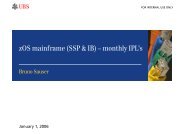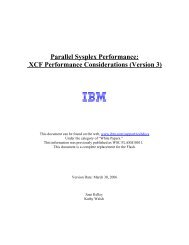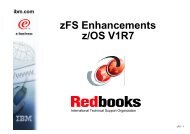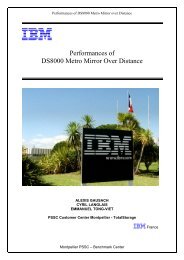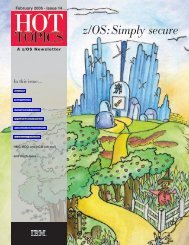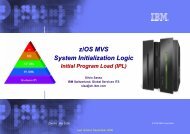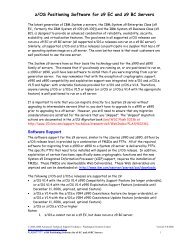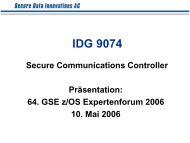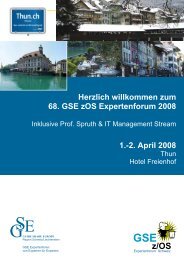Migrating to zOS R8 Part 1 - Messmer The Brain House
Migrating to zOS R8 Part 1 - Messmer The Brain House
Migrating to zOS R8 Part 1 - Messmer The Brain House
Create successful ePaper yourself
Turn your PDF publications into a flip-book with our unique Google optimized e-Paper software.
DFSMSdfp (TM)<br />
DFSMSdss<br />
DFSMShsm (and<br />
DFSMSdss)<br />
DFSMSrmm<br />
DFSMStvs<br />
DFSORT (TM)<br />
Distributed File Service<br />
z/OS V1<strong>R8</strong><br />
z/OS V1<strong>R8</strong><br />
z/OS V1<strong>R8</strong><br />
z/OS V1<strong>R8</strong><br />
z/OS V1<strong>R8</strong><br />
z/OS V1R5<br />
z/OS V1<strong>R8</strong><br />
<strong>Migrating</strong> <strong>to</strong> z/OS <strong>R8</strong> <strong>Part</strong> 1 of 3: Get Ready<br />
security, and distributed time services. This element is at the Open Group<br />
Open Software Foundation (OSF) DCE 1.1 level.<br />
DCE Base Services uses the limited DES algorithm for encryption.<br />
Type: base element, exclusive.<br />
DFSMSdfp provides s<strong>to</strong>rage, data, program, and device management<br />
functions. Related optional features are DFSMSrmm (TM) , DFSMSdss (TM) ,<br />
DFSMShsm (TM) , and DFSMStvs.<br />
As of z/OS V1R3 and z/OS.e V1R3, the program management binder is<br />
moved <strong>to</strong> the BCP base element.<br />
Type: optional feature, exclusive, priced, can be dynamically enabled.<br />
DFSMSdss copies and moves data for backup and recovery, and <strong>to</strong> reduce<br />
free-space fragmentation.<br />
Type: optional feature, exclusive, priced, can be dynamically enabled.<br />
DFSMShsm provides au<strong>to</strong>mated DASD s<strong>to</strong>rage management, including<br />
space management for low and inactive data, and availability management<br />
for accidental data loss caused by local and site disasters. DFSMShsm also<br />
lets you make effective use of tape media.<br />
DFSMShsm requires DFSMSdss. For this reason, DFSMShsm is not<br />
available by itself. If you want <strong>to</strong> use DFSMShsm, you must order the<br />
DFSMShsm/DFSMSdss combination. (DFSMSdss is also available by itself<br />
for those who do not want DFSMShsm.)<br />
Type: optional feature, exclusive, priced, can be dynamically enabled.<br />
DFSMSrmm helps you manage your removable media as one<br />
enterprise-wide library across systems that can share DASD.<br />
Type: optional feature, exclusive, priced, can be dynamically enabled.<br />
DFSMS Transactional VSAM Services (DFSMStvs) enables batch jobs and<br />
CICS online transactions <strong>to</strong> update shared VSAM data sets concurrently.<br />
DFSMStvs was introduced in June 2003 as an optional feature of z/OS<br />
V1R4 and z/OS.e V1R4.<br />
Type: optional feature, exclusive, priced, can be dynamically enabled.<br />
DFSORT provides fast and easy sorting, merging, copying, reporting, and<br />
analysis of your business information, as well as versatile data handling at<br />
the record, field, and bit level. DFSORT also includes the high-performance<br />
ICEGENER facility, the versatile ICETOOL utility, Symbols, and multiple<br />
output capability with the powerful OUTFIL feature.<br />
As of z/OS V1R2, DFSORT is exclusive <strong>to</strong> z/OS because the product<br />
DFSORT V1R14 (5740-SM1) is no longer marketed.<br />
Type: base element, exclusive.<br />
Distributed File Service provides:<br />
w <strong>The</strong> DCE file serving (DFS (TM) ) component of the Open Group Open<br />
Software Foundation (OSF) DCE. <strong>The</strong> file serving support (the DFS<br />
client and server) is at the OSF 1.2.2 level.<br />
w <strong>The</strong> zSeries File System (zFS). <strong>The</strong> zFS is a UNIX file system that<br />
can be used in addition <strong>to</strong> the Hierarchical File System (HFS). zFS<br />
file systems contain files and direc<strong>to</strong>ries that can be accessed with<br />
the z/OS and z/OS.e hierarchical file system file APIs. zFS file<br />
systems can be mounted in<strong>to</strong> the z/OS UNIX hierarchy along with<br />
other local (or remote) file system types (such as HFS, TFS,<br />
AUTOMNT, and NFS). <strong>The</strong> zFS does not replace the HFS; it is<br />
complementary <strong>to</strong> the HFS. As of z/OS V1R7, you can use any<br />
combination of HFS and zFS file systems. zFS can be used for the<br />
root file system. Because zFS has higher performance characteristics<br />
than HFS and is the strategic file system, HFS might no longer be<br />
SHARE (c) Copyright IBM Corporation, 2006 August 15, 2006<br />
Session 2870 Page 54 of 70 Baltimore, MD




